Results
-
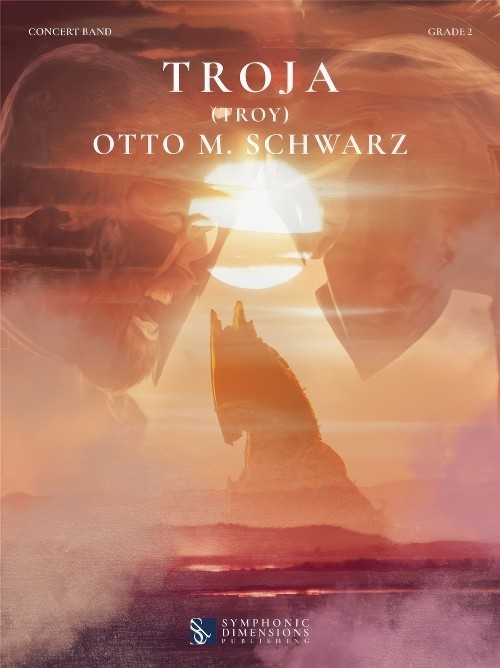 £79.99
£79.99Troja (Troy) (Concert Band - Score and Parts) - Schwarz, Otto M.
The Greek poet Homer wrote about Troy and the Trojan War, which probably took place in what is now Asia Minor, in his Iliad in the 8th century B.C. Nowadays, the term Trojan generally refers to a malware program that is used to gain unauthorised access to computers. This use comes from the legendary Trojan Horse, which saw the turning point in the battle between Greeks and Trojans through the cunning of Odysseus. Let us return to the beginning of the story: Paris, son of the king of Troy, is tasked by Zeus with judging the beauty of the three goddesses Aphrodite, Pallas Athena, and Hera. Aphrodite, the goddess of love, flatters Paris by promising him the most beautiful woman in the world. Soon afterwards, on a journey to Greece, Paris meets the beautiful Helen, who immediately falls in love with him. Since however she is the wife of Spartan king Menelaus, she eventually lets herself be kidnapped by Paris voluntarily. The Greeks then form a large army and go to war against Troy to retrieve Helen, leading to a ten-year siege of the city. The city is eventually conquered not through combat, however, but through Odysseus' cunning ploy. He has the idea of building an enormous wooden horse with warriors hidden inside. The horse is placed at the gates of the city. Thus, the Trojans are tricked into giving up the siege when, despite various warnings, they bring the horse into the city to dedicate it to the goddess Athena. At night, the soldiers climb out of the horse and open the gate for the Greek army. The troops storm the city and burn it to the ground. The royal family and all the Trojan warriors are killed, only Aeneas, the son of Aphrodite, escapes. Later, following many years' wanderings he and his acolytes will become known as the founders of the Roman people. There are various accounts of the fate of the beautiful Helen. She is said to have returned to Sparta with Menelaus and to have ruled there until the end of her life. Or maybe not...Duration: 6.00
Estimated dispatch 7-14 working days
-
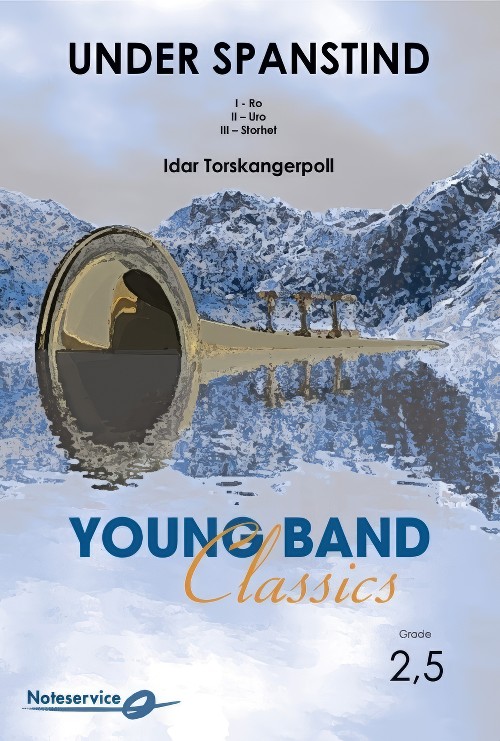 £85.00
£85.00Under Spanstind (Concert Band - Score and Parts) - Torskangerpoll, Idar
Suite in Three MovementsThis piece of music is a commissioned work for Lavangen School band and their band music convention in 2019. The piece was performed under the mountain Spanstind (located far north in Norway) by a band consisting of approx 400 amateur musicians. The mountain Spanstind is 1457 meters high and drops into the valley Spansdalen below, an especially scenic venue.The composition is inspired by the sami joik (folk song) Ru?gu?ohkka, the song to Spanstinden. It is also inspired by the nature of the surroundings. Mvt 1 "Ro" (calmless) describes the feeling of calmness in the midnight sun. Mvt. 2 "Uro" (unrest) describes a scene of wind, snow, avalance and the big forces of nature. Mvt 3 "Storhet" (greatness) describes the feeling of greatness the nature has, and how we experience it as majestic and exalted.The piece can be played with the movements alone, or one can add the signals played by soloist(s) off-stage or in the back of the hall. The signals are to be played before, in between, and after the 3 movements. All instruments can be soloists. The soloist performs the signals rhythmically aleatoric, where each soloist repeats the signal 4 times in his or her own tempo. Signal 1 is played before Mvt 1, signal 2 is played between Mvt 1 and 2, signal 3 is played between Mvt 2 and 3, and signal 4 is played while the band holds the last note (long, use stagger breathing). after a while, all the soloists end on the same note and the music fade out.Duration: 6.30
Estimated dispatch 7-14 working days
-
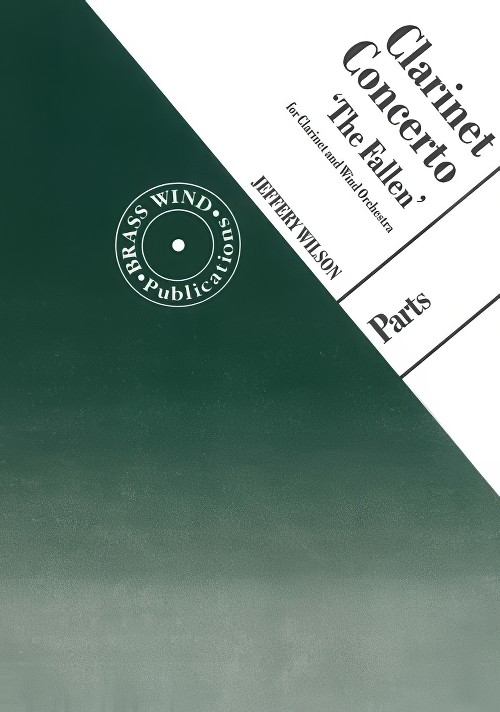 £80.00
£80.00Clarinet Concerto (The Fallen) (Clarinet Solo with Concert Band - Score and Parts) - Wilson, Jeffery
The three movements are 'Conflict', 'The Fallen' and 'Resolution', themes that are freely interpreted musically. In 'Conflict', the solo clarinet begins with an ascending figure based on octave leaps, while the accompaniment contrasts with marcato quavers and harsh dissonances. The melody features seventh intervals, and while the movement is marked 3/4 the accompaniment is often 6/8. This is more evident in the second theme where the clarinet line moves much more by step. The development takes these ideas and the cadenza comes from yet more conflict between the now calm clarinet and dissonant clashes in the accompaniment. 'The Fallen' is the slow movement and poignantly features notes from 'The Last Post' in the opening and a beautiful working of 'David of the White Rock' later on. The final movement 'Resolution' is a Rondo in 6/8, brighter but with hints of the initial conflict through the sevenths in the meno mosso sections which interrupt the flow. Another long cadenza takes short ideas from the piece before the work comes to a triumphant end with all four E notes across the whole range, echoing the beginning. Wilson set out to write a concerto for a versatile instrument and has found ways to exploit its capabilities while keeping tonal centre. There are frequent altissimo notes within all three movements. Wilson does use the very low notes, most notably in the cadenzas, but much of the work is high, presumably to allow the clarinet to carry over the wind band accompaniment. A good command of all notes right up to A sharp an octave above the stave is needed, plus technique to travel to and from altissimo notes (legato). The piece is around 25 minutes long. Printing is clear and the piano accompaniment comes as a spiral bound volume.
Estimated dispatch 7-14 working days
-
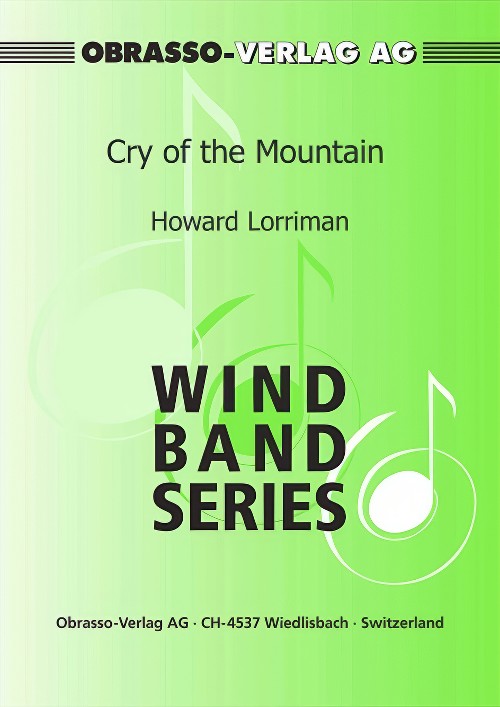 £113.90
£113.90Cry of the Mountain (Concert Band - Score and Parts) - Lorriman, Howard
This work is dedicated to Manfred Obrecht, conductor and musical editor. Manfred asked the composer to write a piece that captures the changing colours and mood of a mountain when viewed from a relatively close distance. The work is in four sections:Awakening - early morning and the mountain is covered in cloud, eventually the sun bursts through and reveals the mountain in all its glory.Snow, Ice and Glaciers - between the rocky out-crops ther are layers of snow; slippery ice patches and icicles adorn the overhangs. In the larger crevices and valleys glaciers are formed.Vistas and Distant Peaks - when viewed from other high points one can see the mountain in full outline against the vast landscape.Avalanche - despite its beauty, a mountain can be a dangerous place and the accumulated snow may not be stable, it can easily tumble out of control. The slight twist of major tonalities at the very end reflects the way a sudden change in light can alter the whole perspective.
Estimated dispatch 7-14 working days
-
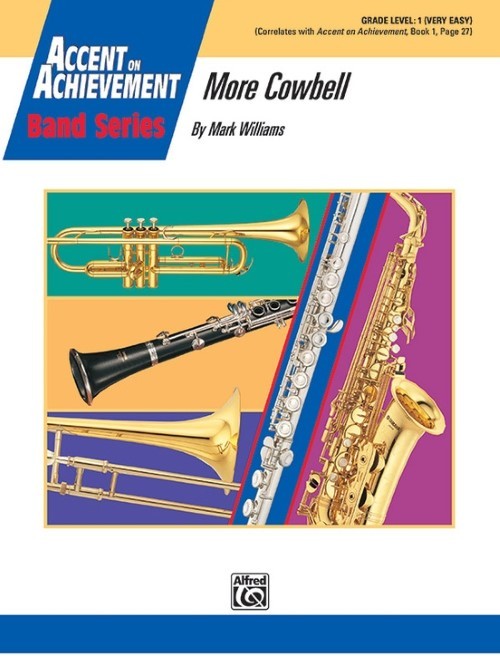 £48.95
£48.95More Cowbell (Cowbell Feature with Concert Band - Score and Parts) - Williams, Mark
More Cowbell was inspired by the famous television skit featuring a rock band, a record producer, and an over-zealous cowbell player. If the cowbell player is good at hamming it up (and rocking out!), you could try the following staging suggestions: Cowbell player plays with intensity and lots of movement, and starts moving in measure 17 toward the front of the band, ending up next to the conductor in measure 24, bowing to the audience on beat 4. Conductor gives a stern look and gestures to student to get back in the percussion section (possibilities: "slit throat" gesture with side of first finger followed by pointing forcefully to the back, or similar gestures). Student slinks back, starts playing cowbell again, but quietly this time. Playing gradually picks up intensity, and player starts again toward the front in measure 41, reaching the front by measure 48. In measure 48, either A) Conductor waves hands violently for student to stop, or B) have a couple of students place a large blanket over the cowbell player. This works, but only for one measure (player quits and doesn't move in bar 49). Cowbell player resumes playing with a vengeance in measure 50 (either in spite of the teacher or under the blanket!). Make sure your new "rock star" takes another bow at the end of the piece. Have fun, and may your life always have more cowbell! Duration: 2.00
Estimated dispatch 7-14 working days
-
 £176.50
£176.50Masquerade (Concert Band - Score and Parts) - Sparke, Philip
Masquerade was commissioned by Stadtmusik Willisau from Switzerland (Reto Gdel, conductor) to celebrate their 175th anniversary in 2003 and first performed by them in November that year.1. Overture: The first movement opens with a fanfare-like figure, featuring the brass, before the main them is introduced over staccato chords. After a short, syncopated interlude a legato theme is introduced in the tenor register and material is developed until the music slows temporarily. The opening theme returns and the 'tenor' tune is taken up by the whole band until the opening fanfare returns to close the movement.2. Elegy: The slow movement opens intensely with a bare two-part theme, which leads to a passionate chorale-style melody. A second theme is introduced and leads to a climax, a return of the chorale theme and a pianissimo repeat which again leads to a full-band climax. The two-part theme returns quietly to create a peaceful close.3 Interlude: A short movement which changes the mood to introduce...4 Finale: Three violent chords preface a lively syncopated opening theme. The trumpets introduce a second idea, which is treated fugally, and this in turn leads to the main melodic idea of the movement, over staccato chords. A contrasting subject is then introduced in the middle of the band, followed by echoes of the first movement fanfare. The opening theme returns and material is revisited until the opening fanfare returns in full to end the work triumphantly.Duration: 15:30
Estimated dispatch 7-14 working days
-
 £124.95
£124.95SWORD AND THE CROWN, The (Prestige Concert Band - Score and Parts) - Gregson, Edward
In 1988 I was commissioned by the Royal Shakespeare Company to write the music for The Plantagenets trilogy, directed by Adrian Noble in Stratford-upon-Avon. These plays take us from the death of Henry V to the death of Richard III. Later, in 1991, I wrote the music for Henry IV parts 1 and 2, again in Stratford. All of these plays are concerned with the struggle for power (the crown) through the use of force (the sword) and they portray one of the most turbulent periods in the history of the British monarchy.This work quickly became established in the mainstream repertoire and has received performances worldwide as well as five commercial recordings and many broadcasts. In 2002 I was approached by the Parc and Dare Band regarding their summer festival and commissioned to do a version for brass band. This was given its first performance in Treorchy Hall by the combined bands of Black Dyke and Parc and Dare conducted by Nicholas Childs.When the Royal Air Force Music Services commissioned me to write a work especially for their British tour in 1991 I immediately thought of turning to this music and transforming some of it into a three-movement suite for symphonic band.The first movement opens with a brief fanfare for two antiphonal trumpets (off-stage), but this only acts as a preface to a Requiem aeternam (the death of Henry V) before changing mood to the English army on the march to France; this subsides into a French victory march, but the English army music returns in counterpoint. Finally, a brief reminder of the Requiem music leads to the triumphal music for Richard Plantagenet, Duke of York, father of Edward IV and Richard III (the opening fanfare transformed).The second movement takes music from the Welsh Court in Henry IV (part 1) which is tranquil in mood; distant fanfares foreboding battles to come are heard, but the folktune is heard three times in different variations and the movement ends as it began with alto flute and gentle percussion.The final movement starts with two sets of antiphonally placed timpani, drums and tam-tam, portraying the 'war machine' and savagery of battle. Trumpet fanfares and horn calls herald an heroic battle theme which, by the end of the movement, transforms itself into a triumphant hymn for Henry IV's defeat of the rebellious forces.- Edward GregsonPerformance time 13'54"Recorded on QPRM117D FESTIVAL OF MUSIC 1991, Massed Bands of the Royal Air ForceRecorded on QPRM120D THE SWORD AND THE CROWN, Central Band of the Royal Air Force'Finale' recorded on QPRM142D FESTIVAL OF MUSIC 2002, Massed Bands of the Royal Air Force)
Estimated dispatch 7-14 working days
-
 £159.99
£159.99The Spirit of Winnipeg - Georges Sadeler
During the last ice age, Glacial Lake Agassiz was the largest lake in the world, spanning vast areas of Canada and the USA, with numerous lakes forming in its basin, including Lake Winnipeg. The beginning of this composition illustrates how the ice of the prehistoric glacier slowly melts, drop by drop, signaling the end of the ice age. Vegetation in Canada begins to flourish once again, and the first rays of a new era illuminate the majestic Lake Winnipeg. Life reawakens as Canada's indigenous people sing their sun dance, traverse the prairie on horseback, and engage in hunting. The conclusion of the composition pays tribute to this splendid, shimmering Lake Winnipeg and its indigenous inhabitants.
Estimated dispatch 7-14 working days
-
 £174.99
£174.99The Graces of Love - Oliver Waespi
"The Graces of Love" (Le Gratie d'Amore) is the title of a book published in 1602 by Cesare Negri, the famous dance master of the Milanese court in the Renaissance. It contains numerous dance tunes and precise descriptions of courtly dances. It also includes the tune 'Il bianco fior' (The White Flower) on which the first movement of Oliver Waespi's piece is based. A vigorous dance in three-four, it leads to an acceleration and a sudden shift to an even meter towards the end. The second movement, calm and contemplative in character, features the tune 'Vaghe bellezze ...' (Veiled Beauty ...). Widely spaced melodic parts surround two solos during which the tune is varied anddeveloped. Finally, the third movement contains a Saltarello based on a tune by Vincenzo Galilei, the father of the famous astronomer, Galileo Galilei. It brings the work to a close with a hypnotic rhythm which is noble and virtuosic at the same time.
Estimated dispatch 7-14 working days
-
 £392.50
£392.50Prillar&Halling - for Solo Clarinet and Wind Band - Stig Nordhagen
Prillar has it's origin from Norwegian folklorist music. It's a way of calling and singing the cattle home from the fields. Halling is a wellknown folk dance from the valleys in the eastern part of Norway. In this work, the clarinet use the prillar to get the other musicians to join in. The melodic material in Prillar and Halling hasn't got all the sound of Norwegian folklore exclusively. You can also hear folkloric music from other nations. The idea is to show the similarities between these and also the small differences there are between folkloristic elements from a large area. The piece also contains the folk tune "Adam in paradise", from south of Norway. At the end, thetunes are stacked on top of each other, and the similarities of origin turns out. - Stig Nordhagen -
Estimated dispatch 7-14 working days
